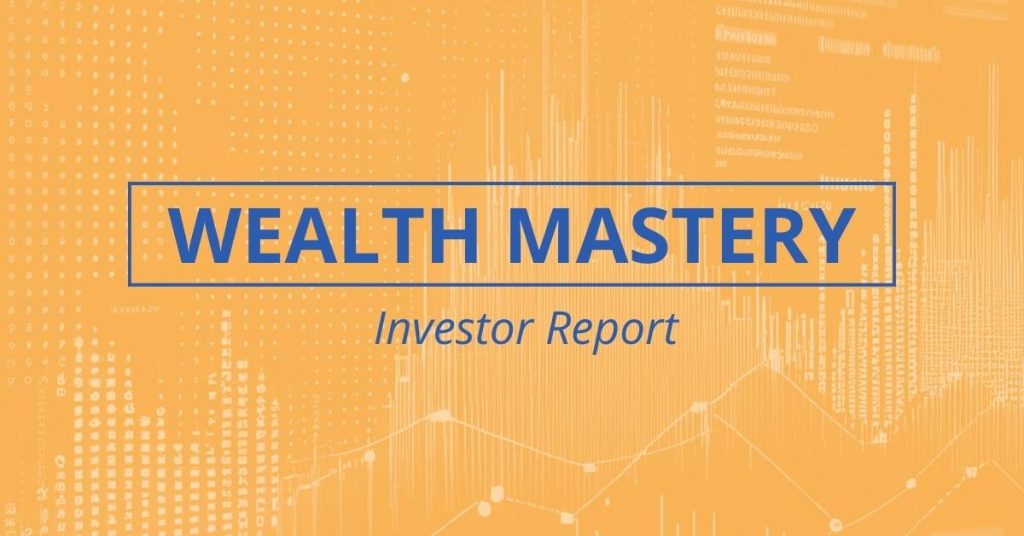The Team from Parallel Finance, Monero vs Zcash & What is Arbitrum Nitro?

In This Issue
- The team from Parallel Finance discusses their mission of bringing decentralized finance to 1 billion people.
- Erik has a report for you on Monero versus Zcash.
- David has a report for you on Arbitrum Nitro.
Premium members also get the following:
- My latest portfolio updates
- Rekt Capital has the latest technical analysis for you on the market.
- Rebecca has all of the latest news for you.
- Upcoming NFT drops
- Defi Dad has a tutorial for you on Defi Dad has a tutorial for you on how to earn up to 6% APY lending ETH on Aave with Morpho.
- Jesse has a ton of hot new airdrops for you.
- Hot new token sales.
- Rebecca breaks down this week’s trending coins.
- Jesse has a deep dive for you on Helium Crypto.
And much more!
Parallel Finance Inverview
For anyone not familiar can you tell us what Parallel Finance is doing?
Parallel Finance is a DeFi super dApp protocol with the mission of bringing decentralized finance to 1 billion people. Parallel was originally built on Kusama and Polkadot networks, with plans to expand its product offering on other chains. We are committed to building a decentralized future that empowers the community, by increasing DeFi accessibility, capital efficiency, and security.
Parallel Finance launched 7 DeFi products with more features planned in the pipeline. The products offered by our DeFi super DApp protocol include: Liquid staking, AMM, decentralized Money Market, liquid crowdloan, stream protocol (DAO tooling), multichain wallet, and yield farming functions.
What is the use case for the PARA token?
PARA has a number of key utilities functions for its holders and users of the Parallel Protocol:
Protocol Governance
PARA holders will each have the ability to vote on all aspects related to the management and administration of Parallel Protocol, through governance, including governance action, referenda, network upgrades, council elections, and parameter adjustments, integrations, changes to incentives, and all other managerial functions.
Transaction Fees
PARA will also function as a means of satisfying network fees natively. It will be required to execute all transactions, including staking, lending, borrowing, crowd loans, trading, and other peer-to-peer and peer-to-pool arrangements.
Security Module Staking
PARA can be staked to a security module to hedge risks in case of staking slashes, and in return, contributors to this insurance pool will be compensated with PARA tokens. The insurance parameters are determined by PARA token governance in the event of a slash.
Polkadot Validator Insurance and Incentivization
Polkadot non-active validators will need PARA to increase their chances of being selected as an active validator based on our algorithm. The PARA will be used as the reserve in the insurance pool to cover for slashing risks.
Can you share some of the key statistics that we should know about?
The best way to check the statistics is through our own analytics website
Some key statistics that should be highlighted are for example:
- largest market share for crowdloan contributions: 22.04%
- Largest TVL of all Polkadot parachains: 479MIO (08/31/22)
- Second largest DOT liquid staking TVL: 17,4MIO (08/31/22)
- Largest DOT native Money market 51,5MIO (08/31/22)
- 41,700 PARA holders
- Value-wise largest polkadot parachain in XCM transfer. Source
What kind of APYs can users get on their assets?
- For PARA 6,5%
- For DOT staking 14,5% + 3,5% in PARA
- For DOT lending 14,7% + 21% in PARA
Also, We just recently launched a LP incentive program for DOT/sDOT and DOT/PARA pairs, giving around 45%-55% APY at the moment.
How has the cross chain transfer upgrade to Polkadot, XCM, affected Parallel?
This has changed everything. and mind you this happened only 3 months ago, so basically you can say that the Polkadot ecosystem and therefore the parallel protocol is only 3 months old.
Only with XCM it was possible to transfer tokens from the relay chain to the parachain of Parallel and back. Only then users could send their DOT to Parallel’s protocol and use them on our protocol. All our products like liquid staking, money market, AMM are based to a very large extent on DOT, which would not be possible without XCM.
XCM enables completely secure communication, sending tokens, not only from the relay chain to parachains, but also from parachain to parachain. We are currently connecting more and more with other parachains like Acala, Moonbeam, Interlay and many others and have added first assets like GLMR to our money market. Many more will follow in shorter intervals until we have united all parachain assets on our protocol.
What are the risks and benefits of liquid staking our DOT?
Everything in crypto has some kind of risks. DOT Liquid staking is still a very secure way to use your DOT. We work with the best validators in the space together very closely and and we have an insurance pool (5% of total PARA supply) for possible slash risks.
The benefits are even greater:
- We can provide higher yield because we work with the best validators together to provide the best possible APY.
- We can incentive additional APY in PARA for DOT staking
- You can instant unstake at any time with the built-in Instant unstake function. It will automatically choose to either swap sDOT for DOT on AMM or unstake through our Money Market, whichever gives the best exchange rate. . Usually you need to wait 29 days for unstaking without getting rewards during this period.
- You can use your sDOT in Parallel’s Money Market as collateral to borrow other assets for more DeFi use cases.
- Overall, liquid staking can significantly improve the Stakers’ capital efficiency and by lowering the opportunity cost, encourage more DOT holders to participate in the act of staking and further enhance the Polkadot network security
What are liquidation free loans and how do they work?
The ‘Liquidation free loan’ is a very unique DeFi feature and in this market situation quite interesting as it has no liquidation risk. A liquidation-free loan is available for users who borrow DOT if and ONLY if they are using cDOT as their collateral.
First of all, what is cDOT? cDOT is the derivative token for a DOT that has contributed to a Polkadot crowdloan. A user who contributed to a crowdloan via Parallel has his DOT locked for 96 weeks but received the derivative token cDOT (crowdloanDOT). You can see it as the “receipt” representing the underlying locked-up DOT. The user can swap it for DOT if he wants his DOT back sooner or wait 96 weeks and then redeem cDOT to DOT. Since 1 cDOT is exactly 1 DOT at the end of the loan period (96 weeks), the user can lend cDOT and use it as collateral to borrow DOT liquidation-free as the value of the collateral and the value of the loan will always be correlated at the end of the lease period (up to 96 weeks).
Can you tell us about the HKO airdrop on Kusama?
It is an incentive program for KSM staking which is designed so that it is more profitable for all when many people stake. Normally there is a very high APY at the beginning and the more people stake their assets the lower it is. We wanted to create a program where it is worth telling your friends and acquaintances about it. The more KSM is staked in this 3 month program, the more HKO rewards you get per KSM. You can read the full details in this article:
People can expect that we will announce something similar with DOT staking soon. Through our Kusama parachains we are trying out many new things and if successful, they will be done on our polkadot parachain as well.
Monero vs Zcash by Erik
Let’s have a look at two important coins that were designed to solve an interesting puzzle: to make transactions on the most public ledger ever – a blockchain – private. Monero and Zcash are the longest-standing and most important privacy coins. What do they have in common and what are the important differences?
Monero and Zcash are so-called privacy coins: they use advanced cryptography to allow users to transact while protecting privacy. A user’s address and balance are not visible. Monero is the biggest privacy coin in terms of market cap. Zcash is slightly smaller. Monero is widely accepted on darknet markets, which is not the case for Zcash. Both are way ahead of the pack in terms of market cap and history.
Both coins are mined and have similar issuance to Bitcoin. Like Bitcoin, Zcash will top out at 21 million coins. Monero has no cap but has a constant inflation rate of 0.6 per block.
Why privacy?
That we close our curtains in the evening doesn’t mean we’re engaging in illegal activities. Same with spending money: wanting privacy in our spending habits doesn’t mean we’re all buying illegal stuff on the dark web. Privacy should be thought of as the default.
But it’s not. Just think of the trail you leave if you transact with a non-privacy network like Bitcoin or Ethereum. On Etherscan or another block explorer, it’s there to see for everyone and forever: entire series of purchases and wallets can be linked to your identity indefinitely.
The problem with privacy settings of protocols, according to Zooko Wilcox, co-founder of Zcash: ‘Privacy isn’t a thing you can add [to applications]. It’s not a feature like a new button or dark mode. You can add features but you can’t really add privacy.’
For that reason, Monero and Zcash approached the entire design with privacy in mind. It’s important to realize that both coins can’t solve the entire privacy problem. In both cases, it’s likely (but not necessary) that you buy the privacy coins at an exchange that knows your data. But how you spend your coins after that, is invisible.
Comparing Zcash and Monero
So let’s compare some basic facts about Monero and Zcash.
| Monero (XMR) | Zcash (ZEC) | |
| Launch | April 2014 | October 2016 |
| Founders | Anonymous | Team from Johns Hopkins Uni |
| Developer community | Big (60+) | ? |
| Funding | Venture capital | Venture capital |
| Market cap (August 2022) | $ 3 billion | $ 1 billion |
| Circulating supply | 18 million | 15 million |
| Supply cap | unlimited, fixed inflation rate | 21 million |
| Consensus mechanism | Proof-of-work | Proof-of-work, talks of moving to proof-of-stake |
| All-time high | $516, May 2021 | $900, Jan 2018 |
| Transparant transactions optional | No | Yes |
| Block size | Adaptable | 2 MB |
| Block time | 2 minutes | 75 seconds |
| Private verification method | Ring signatures | Zero knowledge (zk-snark) |
| Transaction fees | varies, recently much less than $ 0.01 | 0.0001 ZEC (about $ 0,007) |
| Acceptance on darknet markets | high | low |
How does ZCash work?
Zcash is based on the bitcoin protocol. The most important addition is privacy-preserving transaction data using zero-knowledge proofs. Zcash also includes some non-privacy changes to bitcoin, including its proof-of-work algorithm. Just like Bitcoin, the Zcash block mining reward is cut in half every four years. All 21 million are expected to be mined by 2032.
In a recent upgrade (NU5, June 2022), Zcash has introduced features like switching the default setting for transactions to anonymous
Transparent and shielded Zcash transactions
Zcash uses two types of addresses and transactions: transparent ones (starting with a t) and private ones (starting with a z). So privacy is like a switch that can be put on and off. Fully transparent Zcash transactions are like BTC transactions: sender, receiver and amount are publicly visible. In fact, most ZCash transactions are transparent.
However, with a fully-shielded Zcash transaction, the sender, recipient, and amount are fully encrypted and completely private. These transactions are heavier to process and thus not supported by every wallet.
In the recent upgrade, Zcash introduced unified addresses. With unified addresses, people don’t have to choose between privacy and convenience or between multiple address types.
The origin of Zcash’s privacy technology
This protocol was developed in 2014 by scientists and research cryptographers at Johns Hopkins University, Massachusetts Institute of Technology (MIT). Zooko Wilcox, one of them, talks about how they were looking to solve the issue with Bitcoin’s privacy characteristics:
“The bitcoin architecture so pervasively leaks information about all of the users that [adding privacy would be] kind of like plugging a sieve. You know, you can’t really plug all the holes when you start with that as your basis.”
At the time (the early 2010s), zero-knowledge proofs – a verification technique that shields data – were not sufficiently developed. According to Wilcox, Satoshi Nakamoto realized this too and settled for Bitcoin without solid privacy features. Only after Satoshi disappeared, cryptographers came up with zero-knowledge proofs that were good enough to use.
Zcash was the first project to implement zk-SNARKs, a novel form of zero-knowledge cryptography. It is a proof protocol that ensures privacy, anonymity, and fungibility of Zcash coins. Zero-knowledge proofs in the case of Zcash mean that the protocol can know that you have enough funds to make a transaction without actually gaining access to the exact amount.
Move to Proof-of-stake?
Currently, the company that is responsible for Zcash research (Electric Coin co.) is researching if the network should switch to a proof-of-stake consensus mechanism.
Where can you buy Zcash (ZEC)?
Major exchanges like Coinbase and Kraken offer ZEC. Zcash itself recommends Gemini, as that exchange offers more privacy options to users.
Which wallets support Zcash?
There’s the full node wallet Zcashd, for advanced users. Then there’s the distinction between wallets that offer the option of shielded transactions versus ones that only support transparent transactions. The Zcash site lists 5 mobile wallets that support shielded transactions.
There are around ten wallets that support Zcash transparent transactions. Hardware wallets Ledger and Trezor support transparent transactions. See an overview of all the wallet options.
How does Monero work?
Monero was created as a grassroots movement by mostly anonymous people, without a pre-mine. it was launched in April 2014.
A peculiar thing about Monero is that in times of network congestion, Monero miners can pay to be allowed to put more transactions in a block. This makes block production flexible and the mempool under control.
Another interesting part of the protocol is the so-called tail emission. Now that 18.4 million Monero have been mined, there is a fixed increase of the supply of 0.6 Monero per block. This will keep the supply steadily increasing and will make the Monero miners, unlike Zcash (or BTC for that matter) less reliant on fees in the future.
Stealth addresses and ring signatures
Monero transactions are untraceable. Coins sent to a recipient are rerouted through an address that is randomly created to be used specifically for that transaction. These addresses are called stealth addresses. It’s like generating a new key every time you make a transaction. The Monero ledger doesn’t record the actual stealth addresses of the sender and recipient.
Monero also uses so-called ring signatures as a means to hide the sources of funds. The ring signature ensures that every Monero transaction between two parties is grouped with other multiple transactions that occur among other unrelated parties. From the outside, you only see a pool of signatures (a ‘ring’) from people to whom the money could have been sent. In an upgrade in August 2022, the number of signers in a ring signature has been upped from 11 to 16, increasing untraceability.
Monero’s optional view key feature
Monero’s transactions are private by default. But it has a partial, optional transparency feature. All users get a “view key” that they can choose to give to others. In this way, they can let others view their account balance and/or access all historical and current transactions. Or access to only specific transactions in the account.
Monero wallets
The hardcore way to run Monero is running a full node and using Monero’s own wallet. Obviously, this offers the highest level of privacy. For users who settle for convenience, there is MyMonero wallet, an intuitive desktop application. Cake is a good mobile iOs wallet. To keep Monero in cold storage, Ledger is the standard option. Here’s a solid article comparing Monero wallets.
Where can you buy XMR?
There is apparently some pressure on exchanges to not list Monero. For US citizens, Kraken is the only big exchange that offers it. For buyers worldwide, Binance is an option (but not Binance US). A popular decentralized exchange to trade XMR is Bisq.
Conclusion
Both Monero and Zcash have proven track records of preserving their users’ privacy. Both have active communities. Monero’s recent upgrade (aug 2022) shows it is very much alive, as did Zcash’s update of June 2022, introducing shielded transactions by default.
The number of markets that accept Zcash, is lower than Monero. Indeed, Monero has been establishing itself as the dominant privacy coin. That is probably why in 2020 the IRS put a 1.25 million bounty on cracking Monero. They still haven’t paid out, which tells you something about the robustness of Monero’s privacy features.
Zcash has faced the criticism that the option of transparent transactions weakens the usability and even creates an attack vector for the private transactions. Zcash would no doubt contest this, and the fact remains that for day-to-day privacy features, Zcash will be more than sufficient – if you’re not at war with the Fed and their friends at Chainalysis. Still, the fact remains that from a usability standpoint (onboarding inexperienced users) Monero’s privacy-by-default looks like the more sensible option – for a privacy coin! It remains to be seen if Zcash’s recent update will improve this situation.
The price appreciation of Monero and especially Zcash isn’t as stellar as that of many other crypto projects. But maybe that’s not the point. Advocates of Monero and Zcash will often suggest keeping Bitcoin for saving and using their privacy coin for spending. How would that work? Through an atomic swap, you could convert some or their Bitcoin to a wallet with Monero or Zcash (so without relying on a third party and thus preserving privacy). You could then use your privacy coin wallet to do your private spending.
Arbitrum Nitro by David
August 31st is a big day for the team at Offchain Labs and the broader Ethereum layer-two (L2) community. On the one-year anniversary of the Arbitrum One release, Offchain Labs is conducting a major mainnet upgrade from Arbitrum One to Arbitrum Nitro. Arbitrum has already gained a reputation as the premier Ethereum L2 scaling solution; so understandably, there is anticipation as Nitro is supposed to further increase the network’s efficiency, resulting in even lower gas fees for Ethereum users.
To help celebrate the upgrade, this article will provide a background and summary of L2s, optimistic roll-ups, Arbitrum One, and Arbitrum Nitro.
Let’s go!
The Problem: High Ethereum Gas Fees
This problem doesn’t need much explaining. During times of high demand, the Ethereum network becomes congested and fees rise as competition for limited block space ensues. 2020 saw average ETH fees from $100 to $500. 2021 had extended periods where average fees ranged from $50 to $150. Not good.
One Solution: Layer 2s
As the free market tends to do, a range of solutions was deployed to cope with the high fees. One solution is L2 blockchain protocols. L2s are built “on top” of the underlying L1 for the purpose of improving the L1’s scalability and efficiency.
Imagine a congested highway. Now imagine a new highway constructed and stacked directly above, and running along with, the congested one. Ramps are built so that cars can get onto the new highway and get moving. Naturally, the first highway becomes less congested. L1 and L2 blockchains work the same way.
One Type of Layer Two: Optimistic Rollups
There are several types of L2 solutions, Optimistic Rollups are one. Optimistic Rollups process and execute transactions on an L2 chain. They then bundle the data of multiple transactions together into a compressed version and send it to the L1 for validation.
What separates Optimistic Rollups from the rest is the fact that they are . . . well . . . optimistic. Optimistic Rollups assume that the L2 transactions are valid when sending over the transaction data to the L1. Thus, Optimistic Rollups are more efficient than other types of L2s because they do not have to expend energy to prove the validity of every transaction.
Optimistic Rollups do have a way to counter fraud and abuse, and this will be discussed in the next section. But at a high level, Optimistic Rollups are ingenious. I think their underlying philosophy is sound – most economic actors, most of the time, act with honesty and integrity. And when the occasional dispute does arise, Optimistic Rollups require the disputing parties to do the heavy lifting to prove validity instead of the network.
Arbitrum One: An Optimistic Rollup L2 for Ethereum
Arbitrum One, launched on August 31, 2021, is an Optimistic Rollup L2 for Ethereum. Its stated purpose was to scale the Ethereum blockchain, which would naturally result in lower gas fees and faster transactions.
And it’s been successful. At the time of this writing, Arbitrum One commands approximately 49% of the Ethereum L2 market share with $2.5B in TVL. Transactions average less than 10 cents, and hundreds of projects are live on the ecosystem, ranging from wallets, dApps, tools, bridges, and NFT products. dApps range from various DeFi products, stablecoin products, exchanges, margin and perpetual trading, and gaming.
Part of Arbitrum’s success is its accessibility. Users connect an applicable Web3 wallet (e.g. Metamask) to one of Arbitrum’s bridges and then move over their assets onto the L2. That’s all it takes to enjoy the power and diversity of the Ethereum blockchain for pennies per transaction.
Let’s dig into some details of Arbitrum One:
- Security: Security is provided from the larger L1 Ethereum blockchain. Any party can ensure correct Layer 2 results, presumably because any party on the L1 can challenge a transaction that they believe to be incorrect. This will make sense after reading 5 below.
- Compatible with ETH: Arbitrum runs an EVM-compatible execution environment for smart contracts. Smart contract programmers can write code on Arbitrum as they would on Ethereum because both systems are essentially written in the same language.
- Scalability: We’ve covered this one. Contracts, computation, and storage are moved onto the Arbitrum network, allowing for higher overall throughput for Ethereum.
- Minimum Cost: Arbitrum was designed to be lightweight and cheap. Proof is in the product, so the design works. Again, part of what makes Arbitrum lightweight is that it’s optimistic – it doesn’t expend energy to prove the validity of transactions unless participants notify the system that there might be a problem.
- Bisection Fraud-Proofs: This is how Arbitrum counters fraud and abuse. Arbitrum assumes that submitted transactions are correct. Bisection Fraud-proofs are the safety net when an infrequent dispute does arise. Here are the details:
- After Arbitrum sends over its compressed transaction data to Ethereum, a seven-day challenge period opens where anyone can challenge the validity of a proposed transaction. If one party (Bob) disputes a transaction with another party (Alice) during this challenge period, then the Arbitrium code activates a dispute resolution protocol via Bisection Fraud-Proofs.
- Because a single transaction actually has multiple technical steps, the protocol will divide all the steps into two baskets, and ask Bob to identify which basket has the problem. After Bob selects the basket, the protocol will take all the steps in that selected basket, divide it in half, and ask Bob to select which one has the problem. The protocol will keep doing this until the dispute centers on one technical step. Once that step has been identified, the L1 smart contract will compare what the step actually does to Alice’s claim about it.
- The honest party is then rewarded and the liar is penalized via slashing.
To repeat, Arbitrum assumes all transactions to be correct unless someone initiates a challenge. Challengers are required to put in the work to show that they are correct. Not the network.
Arbitrum Nitro: An Ethereum L2 Optimistic Rollup on Nitrous Oxide
Arbitrum Nitro goes live on August 31st, 2022. Offchain Labs claims it will be simpler, faster, and cheaper than Arbitrum One. If this is realized, then Arbitrum Nitro should be a massive hit, given the success of its predecessor.
Here are the high-level details of Nitro:
- Optimistic Rollup Design – Nitro will retain its Optimistic Rollup design.
- Nitro functions by doing sequencing followed by deterministic execution.
- Nitro uses code that functions as a Sequencer. The Sequencer takes transactions on a first come first serve basis and puts them into proper order.
- Once the transactions are in the proper order, the Sequencer publishes a feed of the transaction sequence to all the Arbitrum validators. This happens in less than a second from when the transactions were sequenced.
- After the feed is published, the transactions are read and processed with another piece of code called a State Transaction Function (STF). The STF is deterministic. The same inputs will always produce the same outputs.
- The STF processes and executes the transactions and then updates the L2 chain with a new block.
- Arbitrum then batches all the transactions together, compresses the data, and then sends the compressed data to the ETH chain.
- The seven-day challenge period begins. And once the transactions have finality on Ethereum, then those transactions are final on Arbitrum.
- The takeaway is that any Arbitrum node can independently operate the STF and know what the new L2 block will be. This is because STF is deterministic. Arbitrum nodes can see the eventual state of the chain the moment the feed is published (step c). This provides the network additional oversight and security.
- Go Ethereum (Geth) is the core of Nitro’s software. Nitro differs from Arbitrum One in that Nitro is written in Geth, which is Ethereum’s most authoritative code. Ultimately, this makes Nitro even more seamless and compatible with Ethereum.
- Nitro separates transaction execution from proving the validity of a transaction.
- Arbitrum validators and users can run an Arbitrum node from their machine. This facilitates the execution of transactions. Running a node entails operating Getth and a program called ArbOS.
- Nitro uses the same bisectional fraud-proof design as explained above. But the difference is Nitro runs the fraud-proof software on WASM, a separate part of the network. This results in overall increased efficiency and speed. And according to Offchain Labs, this is the core trick that allows Nitro to be so fast as compared to its predecessor.
Final Thoughts on Arbitrum Nitro
Arbitrum Nitro is looking to improve on an already successful L2 solution. Nitro retains Arbitrum One’s Optimistic Rollup design and bisectional fraud-proof scheme. However, Nitro is an upgrade due to being written in Geth and having the execution and proving functions working on separate areas of the network.
Although there is no native token to invest in, the success of Arbitrum Nitro makes Ethereum more successful. Frequent Ethereum users would be wise to leverage Arbitrum, given the relative ease of bridging assets onto the ecosystem, the extremely cheap fees, and the rich ecosystem.
Final Notes
Thank you so much for your support, and I truly hope that today’s issue will give you insights needed to help you master your wealth.
If you are reading this it means you are on the free version of the Wealth Mastery Investor Report, which is great for news and tips on the crypto markets.
If you really want to take advantage of fastest growing asset class EVER, I highly recommend you join us in the Premium Investor Report.
You’ll immediately get access to:
- Deep dive Altcoin report & The Trending Coin Report
- Technical Analysis on the crypto large caps and overall market
- Token sales, Airdrops and DeFi Tutorials
- Updates on the NFT Ecosystem and new mints
- My Investment Portfolio Updates
- Monthly Crypto Alpha Report
See you next time!
Lark and the Wealth Mastery Team
Legal Disclaimer
TCL Publishing ltd (director Lark Davis, owner of Wealth Mastery) is not providing you individually tailored investment advice. Nor is TCL Publishing registered to provide investment advice, is not a financial adviser, and is not a broker-dealer. The material provided is for educational purposes only. TCL Publishing is not responsible for any gains or losses that result from your cryptocurrency investments. Investing in cryptocurrency involves a high degree of risk and should be considered only by persons who can afford to sustain a loss of their entire investment. Investors should consult their financial adviser before investing in cryptocurrency.





Responses